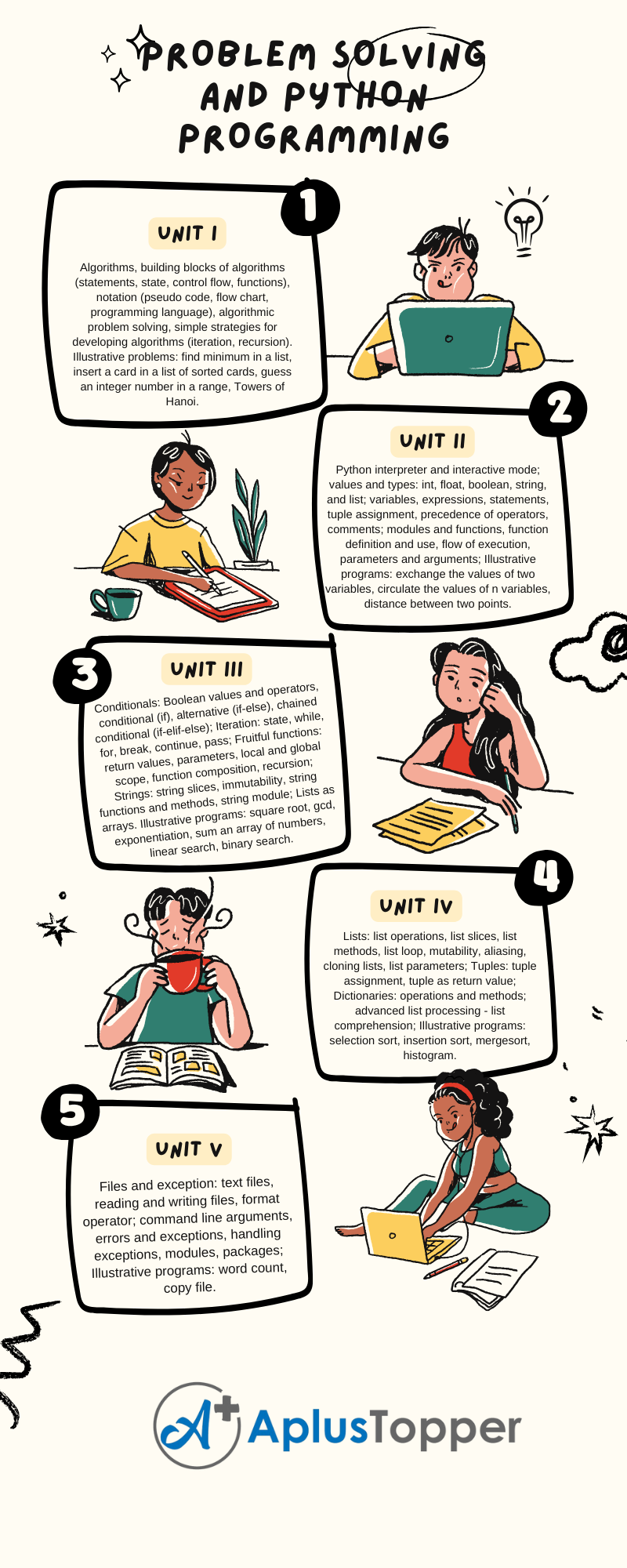Code – GE8151, this article about B.E/B.Tech./B.Arch Mechanical Engineering Semester I Problem Solving And Python Programming syllabus. Students are requested to make notes or PDFs of the semester in Problem Solving And Python Programming for effective preparation from here. It will help you to understand what are the topics in the syllabus.
And to make preparation strategies to score well in the examinations. Unit-wise detailed syllabus is given below in one place, in the following article GE8151 – Problem-Solving and Python Programming Syllabus. If the information helps you, kindly share it with your classmates.
If you want to know more about the syllabus of B.E Mechanical Engineering connected to an affiliated institution’s four-year undergraduate degree programme. We provide you with a detailed Year-wise, semester-wise, and Subject-wise syllabus in the following link B.E Mechanical Engineering Syllabus Anna University Regulation 2017.
Aim Of Concept:
- To know the basics of algorithmic problem-solving.
- To read and write simple Python programs.
- To develop Python programs with conditionals and loops.
- To define Python functions and call them.
- To use Python data structures – lists, tuples, dictionaries.
- To do input/output with files in Python.
GE8151 – Problem Solving And Python Programming Syllabus
Unit I: Algorithmic Problem Solving
Algorithms, building blocks of algorithms (statements, state, control flow, functions), notation (pseudo code, flow chart, programming language), algorithmic problem solving, simple strategies for developing algorithms (iteration, recursion). Illustrative problems: find minimum in a list, insert a card in a list of sorted cards, guess an integer number in a range, Towers of Hanoi.
Unit II: Data, Expressions, Statements
Python interpreter and interactive mode; values and types: int, float, boolean, string, and list; variables, expressions, statements, tuple assignment, precedence of operators, comments; modules and functions, function definition and use, flow of execution, parameters and arguments; Illustrative programs: exchange the values of two variables, circulate the values of n variables, distance between two points.
Unit III: Control Flow, Functions
Conditionals: Boolean values and operators, conditional (if), alternative (if-else), chained conditional (if-elif-else); Iteration: state, while, for, break, continue, pass; Fruitful functions: return values, parameters, local and global scope, function composition, recursion; Strings: string slices, immutability, string functions and methods, string module; Lists as arrays. Illustrative programs: square root, gcd, exponentiation, sum an array of numbers, linear search, binary search.

Unit IV: Lists, Tuples, Dictionaries
Lists: list operations, list slices, list methods, list loop, mutability, aliasing, cloning lists, list parameters; Tuples: tuple assignment, tuple as return value; Dictionaries: operations and methods; advanced list processing – list comprehension; Illustrative programs: selection sort, insertion sort, mergesort, histogram.
Unit V: Files, Modules, Packages
Files and exception: text files, reading and writing files, format operator; command line arguments, errors and exceptions, handling exceptions, modules, packages; Illustrative programs: word count, copy file.
Text Books:
- Allen B. Downey, ‘‘Think Python: How to Think Like a Computer Scientist’’, 2nd edition, Updated for Python 3, Shroff/O’Reilly Publishers, 2016 _(http://greenteapress.com/wp/think- python/)
- Guido van Rossum and Fred L. Drake Jr, “An Introduction to Python – Revised and updated for Python 3.2, Network Theory Ltd., 2011.
References:
- John V Guttag, “Introduction to Computation and Programming Using Python’’, Revised and expanded Edition, MIT Press, 2013
- Robert Sedgewick, Kevin Wayne, Robert Dondero, “Introduction to Programming in Python: An Inter-disciplinary Approach, Pearson India Education Services Pvt. Ltd., 2016.
- Timothy A. Budd, “Exploring Python”, Mc-Graw Hill Education (India) Private Ltd.,, 2015.
- Kenneth A. Lambert, “Fundamentals of Python: First Programs”, CENGAGE Learning, 2012.
- Charles Dierbach, “Introduction to Computer Science using Python: A Computational Problem¬Solving Focus, Wiley India Edition, 2013.
- Paul Gries, Jennifer Campbell and Jason Montojo, “Practical Programming: An Introduction to Computer Science using Python 3”, Second edition, Pragmatic Programmers, LLC, 2013.
If you want to check the syllabus of other branches provided by Anna University, Anna University syllabus Regulation 2017 will assist you in a clear path. Hope you find the required details.
Related Posts Of Semester – I:
- HS8151 – Communicative English Syllabus.
- MA8151 – Engineering Mathematics -1 Syllabus.
- CY8151 – Engineering Chemistry Syllabus.
- PH8151 – Engineering Physics Syllabus.
- GE8152 – Engineering Graphics Syllabus.
- GE8161 – Problem Solving and Python Programming Laboratory syllabus.
- BS8161 – Physics and Chemistry Laboratory Syllabus.
